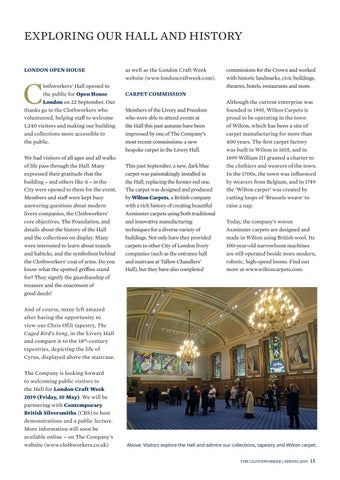EXPLORING OUR HALL AND HISTORY LONDON OPEN HOUSE
C
lothworkers’ Hall opened to the public for Open House London on 22 September. Our thanks go to the Clothworkers who volunteered, helping staff to welcome 1,240 visitors and making our building and collections more accessible to the public. We had visitors of all ages and all walks of life pass through the Hall. Many expressed their gratitude that the building – and others like it – in the City were opened to them for the event. Members and staff were kept busy answering questions about modern livery companies, the Clothworkers’ core objectives, The Foundation, and details about the history of the Hall and the collections on display. Many were interested to learn about teasels and habicks, and the symbolism behind the Clothworkers’ coat of arms. Do you know what the spotted griffins stand for? They signify the guardianship of treasure and the enactment of good deeds!
as well as the London Craft Week website (www.londoncraftweek.com).
commissions for the Crown and worked with historic landmarks, civic buildings, theatres, hotels, restaurants and more.
CARPET COMMISSION Members of the Livery and Freedom who were able to attend events at the Hall this past autumn have been impressed by one of The Company’s most recent commissions: a new bespoke carpet in the Livery Hall. This past September, a new, dark blue carpet was painstakingly installed in the Hall, replacing the former red one. The carpet was designed and produced by Wilton Carpets, a British company with a rich history of creating beautiful Axminster carpets using both traditional and innovative manufacturing techniques for a diverse variety of buildings. Not only have they provided carpets to other City of London livery companies (such as the entrance hall and staircase at Tallow Chandlers’ Hall), but they have also completed
Although the current enterprise was founded in 1995, Wilton Carpets is proud to be operating in the town of Wilton, which has been a site of carpet manufacturing for more than 400 years. The first carpet factory was built in Wilton in 1655, and in 1699 William III granted a charter to the clothiers and weavers of the town. In the 1700s, the town was influenced by weavers from Belgium, and in 1749 the ‘Wilton carpet’ was created by cutting loops of ‘Brussels weave’ to raise a nap. Today, the company’s woven Axminster carpets are designed and made in Wilton using British wool. Its 100-year-old narrowloom machines are still operated beside more modern, robotic, high-speed looms. Find out more at www.wiltoncarpets.com.
And of course, many left amazed after having the opportunity to view our Chris Ofili tapestry, The Caged Bird’s Song, in the Livery Hall and compare it to the 18th-century tapestries, depicting the life of Cyrus, displayed above the staircase. The Company is looking forward to welcoming public visitors to the Hall for London Craft Week 2019 (Friday, 10 May). We will be partnering with Contemporary British Silversmiths (CBS) to host demonstrations and a public lecture. More information will soon be available online – on The Company’s website (www.clothworkers.co.uk)
Above: Visitors explore the Hall and admire our collections, tapestry and Wilton carpet. THE CLOTHWORKER | SPRING 2019
15
